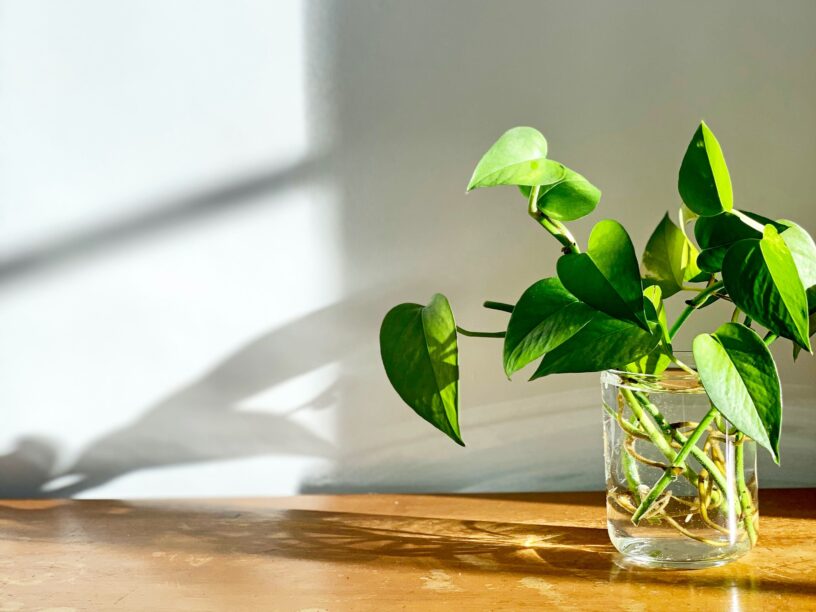Propagation, nodes, aerial roots, rooting hormone, and propagation methods. All very strange words, but fear not, all will be revealed shortly.
What exactly is propagation?
Well, propagation is a way to obtain a “baby” plant from a “mother” plant. In horticulture, it is described as “breeding specimens of a plant from a parent stock.”
Why propagate?
Well, to gift your friends a piece of a plant, to make little plants from your favorite big plants, to make use of the cuttings after giving your plant a haircut, to possibly rescue a dying plant, etc. The possibilities are endless. I usually propagate my plants to gift to my friends and I receive plant cuttings from friends and vendors, which I then have to root to have a full plant.
How to propagate?
Here’s where it gets a little interesting! Propagation methods can vary based on preference, plant and medium.
First and foremost, some plants cannot be propagated, for example palms. The only way to grow certain plants is through seeds. However, lots of plants can be propagated, if I were to list them all, I’d have to publish a volume.
This then begs the question, how do I know which plants I can propagate?
Well, that depends on the plant.
Aerial roots
The easiest way to recognize a propagatable plant is by its node or aerial root. Aerial roots are little brown bumps on the stems of plants. In nature, these aerial roots grow and grab onto trees or other mediums and anchor the plant. In houseplants, they remain “dormant” unless they have something to grab onto, like a moss pole (but we’ll get into that later). Aerial roots are useful for propagating, once you place them into a propagation medium, it grows roots and now you have a new plant!
Some examples of plants with aerial nodes are pothos, syngoniums, monsteras, vining and self-heading philodendrons, peace lilies and many more. Usually, aerial nodes are the easiest to spot on vining plants. It’s harder to find them on a not-yet vining syngonium or a bushy peace lily.
Aside – propagation mediums
There are various way to propagate. Some people place the cuttings directly in water (my preferred method), or you can place them in the soil and keep the soil moist to let the cutting root (being careful not to overwater and rot the cutting). You can also place cuttings in perlite and keep it moist, this is not my favorite method, but I find it useful for propagations that are likely to rot in water. Also, some plants, like Dracaenas, are sensitive to perlite.
You can also use rooting hormone before placing cuttings in soil or water. Rooting hormone contains synthetic auxins, which mimics natural processes in the plant, encouraging root growth. You wet the portion of cutting containing the aerial root or node, dip it in the rooting hormone (which is in powder form) and then place it in the medium of your choice.
A propagation method which has gained popularity with plant influencers is sphagnum moss. I won’t go into detail about how to use sphagnum moss because it has detrimental environmental impacts. I wouldn’t recommend this method as it requires too much time and attention in my opinion and, as mentioned, is bad for the environment.
Cacti and succulents
For cacti with pads like bunny ear cacti, prickly pear cacti, inchworm cacti, Christmas cacti or orchid cacti, you take off a pad where it grows off the pad in the soil and let it scar. Scarring means you don’t plant it directly back in the soil, you let it dry out. Cacti like to be dry and are prone to rotting if you don’t care for them according to their needs, so after the plant has scarred where you pulled it off the mother plant, you can plant it back in the soil. Some people also speed up scarring by dipping the cut part of the cactus in cinnamon and planting it in soil. You can also use rooting hormone here on the cut part of the cactus and put it back in the soil.
Snake plants are also propagatable (this is when I would use the perlite method). You cut off a portion of the leaves and place them in any medium of your choice. However, I find water to be a very ineffective method of propagation snake plants, as the cutting often rots. I know some people use this method, but I have not had success with propagating snake plants in water. After the roots are formed, the snake plant will form a pup (a small snake plant from the mother plant).
Succulents such as echeveria or crassula ovulata can be propagated by taking off a leaf and placing it in or on top of moist soil or on a moist medium, like a moist paper towel in a ziploc. Other succulents like Haworthia are propagatable, but it is difficult to get a leaf from them without damaging the leaf or the plant.
Nodes
Plants with nodes don’t have aerial roots like pothos or philodendrons, but are still propagatable. Nodes are areas where the leaves come out of the stem. Plants like tradescantia and coleus are propagatable through this method. After you take a cutting, remove the leaves on the area of the stem you want to place in your propagation method and place your cutting. It is recommended to have at least 4 leaves on the part of the cutting that isn’t going to be placed in the medium.
Propagation as a means of rescuing a dying plant
Overwatering is the main cause of houseplant death. When you notice a plant is rotting, sometimes you can save some of it before it is too late! You can take cuttings of a part that isn’t rotten yet and avoid a plant casualty.
Lastly, despite my experience and advice, experimentation remains one of the fun things about having houseplants. There’s no wrong way to do anything as long as you’re having fun! Of course there are other propagation methods and propagatable plants that I have not mentioned here. If you have any specific inquiries, message the Iron Warrior and I will be happy to answer.
I wish you all the best in your houseplant ventures!





Leave a Reply